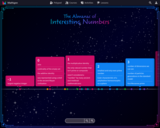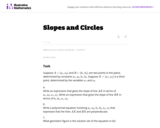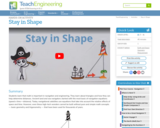
This amazing site from Alberta has interactive for all the strands.
These could be used by students or in small group instruction or as a whole class.
- Subject:
- Math
- Material Type:
- Activity/Lab
- Author:
- Learn Alberta
- Date Added:
- 10/31/2018

This amazing site from Alberta has interactive for all the strands.
These could be used by students or in small group instruction or as a whole class.

Discover Mathigon, the Mathematical Playground. Learning mathematics has never been so interactive and fun!
Check out:
Polypad - Virtual manipulatives, dynamic geometry, graph plotting, data science and more: explore the ultimate mathematical playground!
Multiplication by Heart - These beautiful flash cards use spaced repetition to teach multiplication facts. Achieve fluency with just five minutes of practice per day!
Activities - A selection of our favourite mathematical puzzles and problems. Most are simple to understand, but the solutions require clever and unconventional thinking.
Factris - A fun game that teaches about simple arithmetic
Course Library - Mathigon's innovative courses cover everything from fractions and trigonometry to graph theory, cryptography, prime numbers and fractals.
Puzzles, Activities and Lesson Plans - Student Explorations/Activities for students to complete ; Fully developed lessons plans ; Ready to play puzzles and games ; Teaching ideas using Polypad to explore new ideas; Tutorials - Learn how to use Polypad
Almanac of Interesting Numbers
And much more!

(Nota: Esta es una traducción de un recurso educativo abierto creado por el Departamento de Educación del Estado de Nueva York (NYSED) como parte del proyecto "EngageNY" en 2013. Aunque el recurso real fue traducido por personas, la siguiente descripción se tradujo del inglés original usando Google Translate para ayudar a los usuarios potenciales a decidir si se adapta a sus necesidades y puede contener errores gramaticales o lingüísticos. La descripción original en inglés también se proporciona a continuación.)
En este módulo, los estudiantes aprenden sobre traducciones, reflexiones y rotaciones en el avión y, lo que es más importante, cómo usarlas para definir con precisión el concepto de congruencia. A lo largo del tema A, sobre las definiciones y propiedades de los movimientos rígidos básicos, los estudiantes verifican experimentalmente sus propiedades básicas y, cuando son factibles, profundicen su comprensión de estas propiedades utilizando el razonamiento. Todas las lecciones del tema B demuestran a los estudiantes la capacidad de secuenciar varias combinaciones de movimientos rígidos mientras mantienen las propiedades básicas de los movimientos rígidos individuales. Los estudiantes aprenden que la congruencia es solo una secuencia de movimientos rígidos básicos en el Tema C, y el Tema D comienza el aprendizaje del Teorema Pitagórico.
Encuentre el resto de los recursos matemáticos de Engageny en https://archive.org/details/engageny-mathematics.
English Description:
In this module, students learn about translations, reflections, and rotations in the plane and, more importantly, how to use them to precisely define the concept of congruence. Throughout Topic A, on the definitions and properties of the basic rigid motions, students verify experimentally their basic properties and, when feasible, deepen their understanding of these properties using reasoning. All the lessons of Topic B demonstrate to students the ability to sequence various combinations of rigid motions while maintaining the basic properties of individual rigid motions. Students learn that congruence is just a sequence of basic rigid motions in Topic C, and Topic D begins the learning of Pythagorean Theorem.
Find the rest of the EngageNY Mathematics resources at https://archive.org/details/engageny-mathematics.

(Nota: Esta es una traducción de un recurso educativo abierto creado por el Departamento de Educación del Estado de Nueva York (NYSED) como parte del proyecto "EngageNY" en 2013. Aunque el recurso real fue traducido por personas, la siguiente descripción se tradujo del inglés original usando Google Translate para ayudar a los usuarios potenciales a decidir si se adapta a sus necesidades y puede contener errores gramaticales o lingüísticos. La descripción original en inglés también se proporciona a continuación.)
El módulo 7 comienza con el trabajo relacionado con el teorema de Pitágoras y los triángulos rectos. Antes de que se presenten las lecciones de este módulo a los estudiantes, es importante que las lecciones en los módulos 2 y 3 sean relacionadas con el teorema de Pitágoras se imparten (M2: Lecciones 15 y 16, M3: Lecciones 13 y 14). En los módulos 2 y 3, los estudiantes usaron el teorema de Pitágoras para determinar la longitud desconocida de un triángulo derecho. En los casos en que la longitud lateral era un entero, los estudiantes calcularon la longitud. Cuando la longitud lateral no era un entero, los estudiantes dejaron la respuesta en forma de x2 = c, donde C no era un número cuadrado perfecto. Esas soluciones se revisan y son la motivación para aprender sobre las raíces cuadradas y los números irracionales en general.
Encuentre el resto de los recursos matemáticos de Engageny en https://archive.org/details/engageny-mathematics.
English Description:
Module 7 begins with work related to the Pythagorean Theorem and right triangles. Before the lessons of this module are presented to students, it is important that the lessons in Modules 2 and 3 related to the Pythagorean Theorem are taught (M2: Lessons 15 and 16, M3: Lessons 13 and 14). In Modules 2 and 3, students used the Pythagorean Theorem to determine the unknown length of a right triangle. In cases where the side length was an integer, students computed the length. When the side length was not an integer, students left the answer in the form of x2=c, where c was not a perfect square number. Those solutions are revisited and are the motivation for learning about square roots and irrational numbers in general.
Find the rest of the EngageNY Mathematics resources at https://archive.org/details/engageny-mathematics.

The following resource contains the assets (or resources) to accompany the Sask DLC Mathematics 8 course. Please note that this is not the content of the course, but the assets used to support and deliver it. The files are organized in a zip folder and a collection.

The purpose of this task is to lead students through an algebraic approach to a well-known result from classical geometry, namely, that a point X is on the circle of diameter AB whenever _AXB is a right angle.

Students learn that math is important in navigation and engineering. They learn about triangles and how they can help determine distances. Ancient land and sea navigators started with the most basic of navigation equations (speed x time = distance). Today, navigational satellites use equations that take into account the relative effects of space and time. However, even these high-tech wonders cannot be built without pure and simple math concepts â basic geometry and trigonometry â that have been used for thousands of years.

This task presents a foundational result in geometry, presented with deliberately sparse guidance in order to allow a wide variety of approaches. Teachers should of course feel free to provide additional scaffolding to encourage solutions or thinking in one particular direction. We include three solutions which fall into two general approaches, one based on reference to previously-derived results (e.g., the Pythagorean Theorem), and another conducted in terms of the geometry of rigid transformations.

In this activity, students will use vector analysis to understand the concept of dead reckoning. Students will use vectors to plot their course based on a time and speed. They will then correct the positions with vectors representing winds and currents.